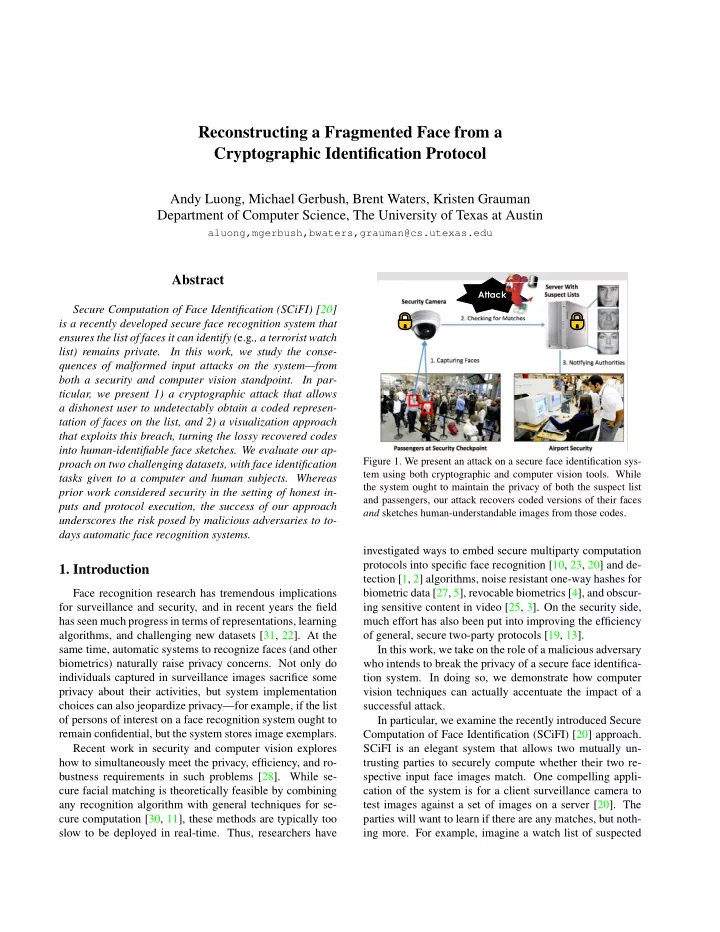

Reconstructing a Fragmented Face from a Cryptographic Identification Protocol Andy Luong, Michael Gerbush, Brent Waters, Kristen Grauman Department of Computer Science, The University of Texas at Austin aluong,mgerbush,bwaters,grauman@cs.utexas.edu Abstract Attack Secure Computation of Face Identification (SCiFI) [20] is a recently developed secure face recognition system that ensures the list of faces it can identify ( e.g ., a terrorist watch list) remains private. In this work, we study the conse- quences of malformed input attacks on the system—from both a security and computer vision standpoint. In par- ticular, we present 1) a cryptographic attack that allows a dishonest user to undetectably obtain a coded represen- tation of faces on the list, and 2) a visualization approach that exploits this breach, turning the lossy recovered codes into human-identifiable face sketches. We evaluate our ap- Figure 1. We present an attack on a secure face identification sys- proach on two challenging datasets, with face identification tem using both cryptographic and computer vision tools. While tasks given to a computer and human subjects. Whereas the system ought to maintain the privacy of both the suspect list prior work considered security in the setting of honest in- and passengers, our attack recovers coded versions of their faces puts and protocol execution, the success of our approach and sketches human-understandable images from those codes. underscores the risk posed by malicious adversaries to to- days automatic face recognition systems. investigated ways to embed secure multiparty computation protocols into specific face recognition [10, 23, 20] and de- 1. Introduction tection [1, 2] algorithms, noise resistant one-way hashes for Face recognition research has tremendous implications biometric data [27, 5], revocable biometrics [4], and obscur- for surveillance and security, and in recent years the field ing sensitive content in video [25, 3]. On the security side, has seen much progress in terms of representations, learning much effort has also been put into improving the efficiency algorithms, and challenging new datasets [31, 22]. At the of general, secure two-party protocols [19, 13]. same time, automatic systems to recognize faces (and other In this work, we take on the role of a malicious adversary biometrics) naturally raise privacy concerns. Not only do who intends to break the privacy of a secure face identifica- individuals captured in surveillance images sacrifice some tion system. In doing so, we demonstrate how computer privacy about their activities, but system implementation vision techniques can actually accentuate the impact of a choices can also jeopardize privacy—for example, if the list successful attack. of persons of interest on a face recognition system ought to In particular, we examine the recently introduced Secure remain confidential, but the system stores image exemplars. Computation of Face Identification (SCiFI) [20] approach. Recent work in security and computer vision explores SCiFI is an elegant system that allows two mutually un- how to simultaneously meet the privacy, efficiency, and ro- trusting parties to securely compute whether their two re- bustness requirements in such problems [28]. While se- spective input face images match. One compelling appli- cure facial matching is theoretically feasible by combining cation of the system is for a client surveillance camera to any recognition algorithm with general techniques for se- test images against a set of images on a server [20]. The cure computation [30, 11], these methods are typically too parties will want to learn if there are any matches, but noth- slow to be deployed in real-time. Thus, researchers have ing more. For example, imagine a watch list of suspected
Recommend
More recommend